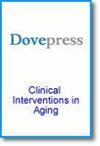Predicting COVID-19 Re-Positive Cases in Malnourished Older Adults: A Clinical Model Development and Validation
IF 3.7
3区 医学
引用次数: 0
Abstract
Purpose: Building and validating a clinical prediction model for novel coronavirus (COVID-19) re-positive cases in malnourished older adults.Patients and Methods: Malnourished older adults from January to May 2023 were retrospectively collected from the Department of Geriatrics of the Affiliated Hospital of Chengdu University of Traditional Chinese Medicine. They were divided into a “non-re-positive” group and a “re-positive” group based on the number of COVID-19 infections, and into a training set and a validation set at a 7:3 ratio. The least absolute shrinkage and selection operator (LASSO) regression analysis was used to identify predictive factors for COVID-19 re-positivity in malnourished older adults, and a nomogram was constructed. Independent influencing factors were screened by multivariate logistic regression. The model’s goodness-of-fit, discrimination, calibration, and clinical impact were assessed by Hosmer-Lemeshow test, area under the curve (AUC), calibration curve, decision curve analysis (DCA), and clinical impact curve analysis (CIC), respectively.
Results: We included 347 cases, 243 in the training set, and 104 in the validation set. We screened 10 variables as factors influencing the outcome. By multivariate logistic regression analysis, preliminary identified protective factors, risk factors, and independent influencing factors that affect the re-positive outcome. We constructed a clinical prediction model for COVID-19 re-positivity in malnourished older adults. The Hosmer-Lemeshow test yielded χ2 =5.916, P =0.657; the AUC was 0.881; when the threshold probability was > 8%, using this model to predict whether malnourished older adults were re-positive for COVID-19 was more beneficial than implementing intervention programs for all patients; when the threshold was > 80%, the positive estimated value was closer to the actual number of cases.
Conclusion: This model can help identify the risk of COVID-19 re-positivity in malnourished older adults early, facilitate early clinical decision-making and intervention, and have important implications for improving patient outcomes. We also expect more large-scale, multicenter studies to further validate, refine, and update this model.
Keywords: malnutrition, COVID-19, re-positive, clinical prediction model
预测营养不良老年人的 COVID-19 再次阳性病例:临床模型的开发与验证
目的:建立并验证营养不良老年人新型冠状病毒(COVID-19)再阳性病例的临床预测模型:回顾性收集成都中医药大学附属医院老年病科2023年1月至5月的营养不良老年人。根据 COVID-19 感染次数将他们分为 "非再阳性 "组和 "再阳性 "组,并按 7:3 的比例分为训练集和验证集。利用最小绝对收缩和选择算子(LASSO)回归分析来确定营养不良老年人COVID-19再次阳性的预测因素,并构建了一个提名图。通过多变量逻辑回归筛选出独立的影响因素。通过Hosmer-Lemeshow检验、曲线下面积(AUC)、校准曲线、决策曲线分析(DCA)和临床影响曲线分析(CIC)分别评估了模型的拟合优度、区分度、校准度和临床影响:我们共纳入了 347 个病例,其中 243 个在训练集中,104 个在验证集中。我们筛选出 10 个变量作为影响结果的因素。通过多变量逻辑回归分析,初步确定了影响再阳性结果的保护因素、风险因素和独立影响因素。我们构建了营养不良老年人 COVID-19 再阳性的临床预测模型。Hosmer-Lemeshow检验结果为χ2 =5.916,P =0.657;AUC为0.881;当阈值概率为> 8%时,使用该模型预测营养不良老年人COVID-19是否再次阳性比对所有患者实施干预计划更有利;当阈值为> 80%时,阳性估计值更接近实际病例数:该模型有助于及早识别营养不良老年人COVID-19再次阳性的风险,促进早期临床决策和干预,对改善患者预后具有重要意义。我们还期待更多大规模、多中心研究进一步验证、完善和更新该模型。关键词:营养不良;COVID-19;再阳性;临床预测模型
本文章由计算机程序翻译,如有差异,请以英文原文为准。
求助全文
约1分钟内获得全文
求助全文
来源期刊

Clinical Interventions in Aging
GERIATRICS & GERONTOLOGY-
CiteScore
6.20
自引率
2.80%
发文量
193
期刊介绍:
Clinical Interventions in Aging, is an online, peer reviewed, open access journal focusing on concise rapid reporting of original research and reviews in aging. Special attention will be given to papers reporting on actual or potential clinical applications leading to improved prevention or treatment of disease or a greater understanding of pathological processes that result from maladaptive changes in the body associated with aging. This journal is directed at a wide array of scientists, engineers, pharmacists, pharmacologists and clinical specialists wishing to maintain an up to date knowledge of this exciting and emerging field.
 求助内容:
求助内容: 应助结果提醒方式:
应助结果提醒方式:


